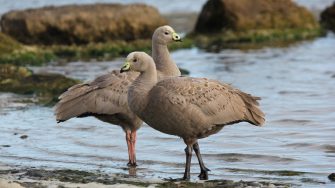
Date: Friday, November 6, 2015
Project: Eastern Australian Waterbird Survey
Observer - Richard Kingsford
We have a routine for the Coorong – get in the air early before the wind and heat get up. So up and in the air by 6.30am. First we surveyed the Murray Mouth, down from the town of Goolwa, right up to where the barrages end. There were a lot of waterbirds on this part of the Coorong, mostly grey teal and chestnut teal. The mouth of the River Murray needs to be kept open with a dredge which was costed at $100,000 a week. This is just one of the symptoms of a system where river flows have declined over nearly the last 100 years.
The dredge making sure the channel out to sea is not silted up by sand because it could plug the mouth of the Murray and increase the salinity.
The mouth of the River Murray with the dredges.
The salt water on this part of the River Murray is separated from the freshwater in Lake Alexandrina by the barrages. These concrete structures were put in the between 1930 and 1940 because there were insufficient freshwater flows coming down the River Murray. The considerable water resource development since then now makes them a necessity. Some recommend removing the barriers and letting the sea come in. This would destroy much of the biodiversity of this system, not to mention the ability of people to divert freshwater from the lakes.
Waterbirds congregate in large numbers where the freshwater pours into the saltwater, capturing food.
The Coorong has a north part and a south part which we count separately. We counted it twice which meant we did a three hour flight up and down and up down. It has incredible numbers of a wide variety of species. My recordings went for two hours of the three hours, calling the numbers of the different species constantly. There are tens of thousands of waterbirds on the Coorong which stretches for 120 km to the south.
Looking south to the Coorong from the Murray mouth.
Pelicans regularly breed on the same island in the South Coorong and they were breeding there again today.
Breeding pelicans on their island in the South Coorong
It was surprising to also see a tern colony on another of the islands while there also seemed to be silver gulls breeding on one of the other islands.
Breeding colony of terns.
After our three hour flight – we rewarded ourselves with a breakfast on the water in Goolwa. Bouncing around and focusing is taxing as well as talking like a race caller for two hours.
Then we did our second survey of the two freshwater lakes, Lake Alexandrina and Lake Albert. This is an immense body of water, with Lake Alexandrina stretching covering near 650 km2.
Lake Alexandrina and its reedbeds stretch out over a vast area.
Unlike yesterday when we surveyed the lakes, the fish eating birds, cormorants and pelicans were clumped in huge flocks of up to a thousand.
Hundreds of great black cormorants and pelicans roost and feed together in huge flocks
We also spent a little more time estimating the sizes of the impressive colonies of pied cormorants and straw-necked ibis. The lakes were obviously highly productive this year for these species as there were more colonies established than in previous years. These are particularly important given the absence of breeding anywhere else in the Murray-Darling Basin, apart from some small colonies in the Barmah-Millewa Forest.
Colony of breeding pied cormorants
Colony of breeding straw-necked ibis
Straw-necked ibis like to set up their colonies in the reedbeds, trampling them down and then nesting ‘cheek by jowl’ in their hundreds.
Colony of about 300-400 straw-necked ibis nesting in the reedbeds of Lake Alexandrina.
There are probably as many as 30-40 waterbird species on this system, many in their tens of thousands. Occasionally there are small flocks of Cape Barren geese grazing in the paddocks beside the lakes. This is a particularly elegant looking waterbird.
A pair of Cape Barren geese on the edge of the water, near the mouth of the River Murray.
It took us another two hours to finish surveying the two lakes. We had today surveyed about 1,000 km of wetland – one of our most important areas for biodiversity in Australia.
